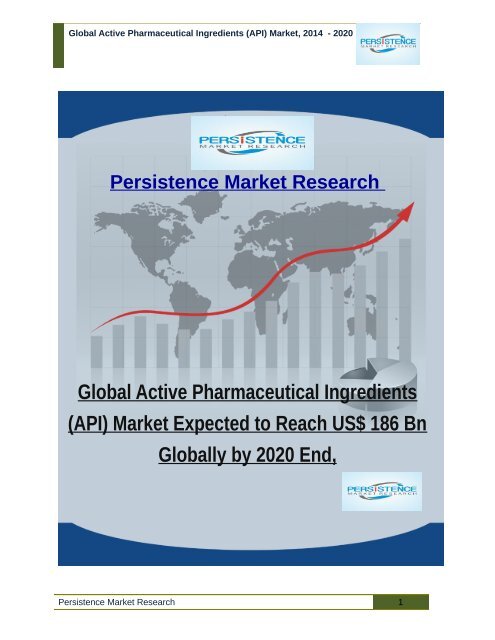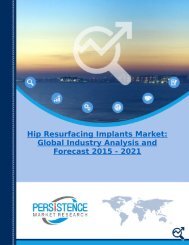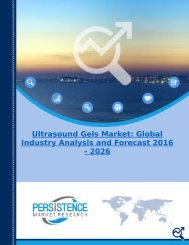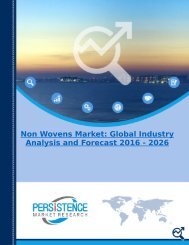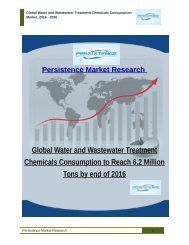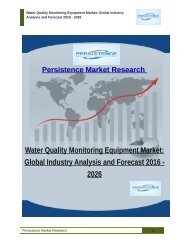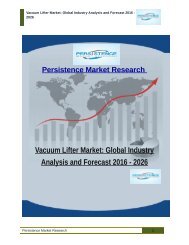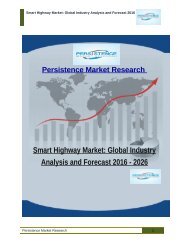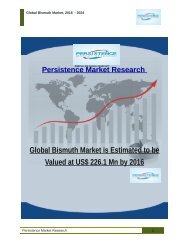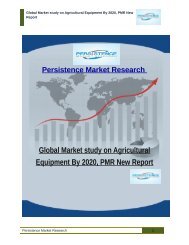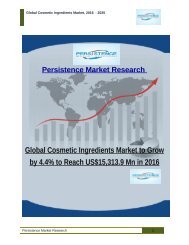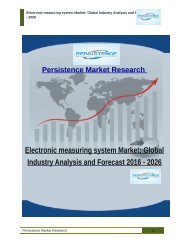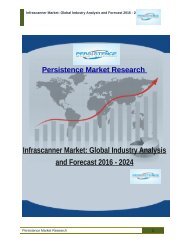Global Active Pharmaceutical Ingredients (API) Market
You also want an ePaper? Increase the reach of your titles
YUMPU automatically turns print PDFs into web optimized ePapers that Google loves.
<strong>Global</strong> <strong>Active</strong> <strong>Pharmaceutical</strong> <strong>Ingredients</strong> (<strong>API</strong>) <strong>Market</strong>, 2014 - 2020<br />
Persistence <strong>Market</strong> Research<br />
<strong>Global</strong> <strong>Active</strong> <strong>Pharmaceutical</strong> <strong>Ingredients</strong><br />
(<strong>API</strong>) <strong>Market</strong> Expected to Reach US$ 186 Bn<br />
<strong>Global</strong>ly by 2020 End,<br />
Persistence <strong>Market</strong> Research 1
<strong>Global</strong> <strong>Active</strong> <strong>Pharmaceutical</strong> <strong>Ingredients</strong> (<strong>API</strong>) <strong>Market</strong>, 2014 - 2020<br />
According to a new market report published by Persistence <strong>Market</strong> Research “<strong>Active</strong><br />
<strong>Pharmaceutical</strong> Ingredient (<strong>API</strong>) <strong>Market</strong>” the global active pharmaceutical ingredient market was<br />
valued at US$ 127 Bn in 2014 and is estimated to reach US$ 186 Bn by 2023 at a CAGR of<br />
6.6% from 2015 to 2020.<br />
<strong>Active</strong> pharmaceutical ingredient (<strong>API</strong>) refers to a therapeutically active ingredient or substance<br />
combination used in manufacturing a drug product. Production of active pharmaceutical<br />
ingredients is a highly sophisticated and technically demanding process. The global active<br />
pharmaceutical ingredient market is surging due to the increased demand for pharmaceutical<br />
drugs, which in turn is driven by aging population, increasing prevalence of chronic diseases<br />
such as cancer, diabetes, cardiovascular, neurological and infectious diseases among others.<br />
Further, fragmented nature of the pharmaceutical supplies market, brings a smaller profit share<br />
to each player.<br />
Browse through the full <strong>Global</strong> <strong>Active</strong> <strong>Pharmaceutical</strong> <strong>Ingredients</strong> (<strong>API</strong>) <strong>Market</strong> report at<br />
http://www.persistencemarketresearch.com/market-research/active-pharmaceutical-ingredientmarket.asp<br />
The global active pharmaceutical ingredient market encompasses geographies such as North<br />
America, Asia Pacific, Europe and Rest of the World. North America accounted for the largest<br />
segment in the global active pharmaceutical ingredients market in 2014 due to fact that North<br />
America is the leading consumer of <strong>API</strong>s and <strong>API</strong> exporters consider North America as the most<br />
lucrative market. India and China are the major suppliers of <strong>API</strong>s to North America due to low<br />
production and labor costs. Moreover, biologics have become one of the top-selling drugs in<br />
North America. Thus, the expected market entry of biosimilars with flexible regulatory process<br />
would boost the <strong>API</strong> market in North America. The <strong>API</strong> market in the U.S. displays high level of<br />
competition, with mergers and collaborations between various key players such as Teva<br />
<strong>Pharmaceutical</strong> Industries Ltd., Sandoz (Novartis AG), Mylan, Inc., and Allergen plc.<br />
Additionally, demand for biological <strong>API</strong>s is high in the region, as technological developments in<br />
the pharmaceutical industry are paving the way for newer biotechnology drugs. These<br />
expansion strategies intensify the competition between the global players, which is a result of<br />
expected high growth in the <strong>API</strong> market.<br />
Asia Pacific ranks second due to the factors such as availability of low cost production facilities<br />
and cheap labor in countries such as India and China. The cost difference ranges from 30% to<br />
Persistence <strong>Market</strong> Research 2
<strong>Global</strong> <strong>Active</strong> <strong>Pharmaceutical</strong> <strong>Ingredients</strong> (<strong>API</strong>) <strong>Market</strong>, 2014 - 2020<br />
60% if the drugs are manufactured in China or India compared to other countries. Hence, China<br />
and India are expected to witness significant growth in the near future due to increase in<br />
production capacities and presence of large number of global and domestic players... Thus,<br />
Asia-Pacific is the most competitive market in <strong>API</strong> and the competition is expected to intensify<br />
between India and China, as these are the most attractive destinations for pharmaceutical<br />
manufacturing.<br />
In Europe pharmacists are offered incentives for substituting branded drugs with generic<br />
versions, which contributes to the growth of the <strong>API</strong> market in the region. Regulations also play<br />
a vital role in the <strong>API</strong> market, as the law disallows development of generic <strong>API</strong>s in Europe until<br />
patent expiry. However, the governments of various countries in Europe have started supporting<br />
the manufacture of generic drugs post the financial crisis. Patent expirations of major<br />
blockbuster drugs in Europe during the forecast period would fuel the growth of the <strong>API</strong> market<br />
in the near future.<br />
View Sample Report: http://www.persistencemarketresearch.com/samples/11260<br />
Request TOC (table of content), Figures and Tables of the Report:<br />
http://www.persistencemarketresearch.com/market-research/active-pharmaceutical-ingredientmarket/toc<br />
Demand for generic drugs is increasing not only in developed countries, but also in developing<br />
and underdeveloped countries in South America and Africa. Brazil’s health authority Agência<br />
Nacional de Vigilância Sanitária (ANVISA) allows the procurement or manufacturing of <strong>API</strong>s<br />
only for companies registered with ANVISA. Moreover, foreign companies find it difficult to enter<br />
the generics market in Brazil, as nearly 80% of the market is controlled by the four local<br />
companies namely, EMS, Medley, Eurofarma and Ache/Biosintetica. According to reports<br />
published by Mexico’s National Association of Drug Manufacturers (ANAFAM), in 2013 86% of<br />
drugs used in Mexico were produced domestically to help curtail rising healthcare costs. Other<br />
factors boosting the <strong>API</strong> market growth in developing regions are cost-efficient manufacturing,<br />
large patient pool, rising demand for generic drugs, and improvement in the healthcare<br />
infrastructure. For the same reasons, the <strong>API</strong> market in South America is developing steadily<br />
and is likely to witness significant growth during the forecast period.<br />
Persistence <strong>Market</strong> Research 3
<strong>Global</strong> <strong>Active</strong> <strong>Pharmaceutical</strong> <strong>Ingredients</strong> (<strong>API</strong>) <strong>Market</strong>, 2014 - 2020<br />
The global active pharmaceutical ingredients market is segmented as given below:<br />
<strong>Global</strong> <strong>Active</strong> <strong>Pharmaceutical</strong> <strong>Ingredients</strong> <strong>Market</strong>, by Manufacturing Process, 2015-2020<br />
(US$ Mn)<br />
Captive Manufacturing<br />
Contract Manufacturing<br />
<strong>Global</strong> <strong>Active</strong> <strong>Pharmaceutical</strong> <strong>Ingredients</strong> <strong>Market</strong>, by <strong>API</strong> Type, 2015 – 2020 (US$ Mn)<br />
Synthetic Chemical <strong>API</strong><br />
Biological <strong>API</strong><br />
<strong>Global</strong> <strong>Active</strong> <strong>Pharmaceutical</strong> <strong>Ingredients</strong> <strong>Market</strong>, by Drug Type, 2015 – 2020 (US$ Mn)<br />
Branded Prescription Drugs<br />
Generic Prescription Drugs<br />
OTC Prescription Drugs<br />
<strong>Global</strong> <strong>Active</strong> <strong>Pharmaceutical</strong> <strong>Ingredients</strong> <strong>Market</strong>, by Therapeutic Area, 2015 – 2020 (US$<br />
Mn)<br />
Cardiovascular Disorders<br />
Metabolic Disorders<br />
Neurological Disorders<br />
Oncology<br />
Musculoskeletal Disorders<br />
NSAIDs<br />
Other Therapeutics Uses<br />
<strong>Global</strong> <strong>Active</strong> <strong>Pharmaceutical</strong> <strong>Ingredients</strong> <strong>Market</strong>, by Geography, 2015 – 2020 (US$ Mn)<br />
North America<br />
Persistence <strong>Market</strong> Research 4
<strong>Global</strong> <strong>Active</strong> <strong>Pharmaceutical</strong> <strong>Ingredients</strong> (<strong>API</strong>) <strong>Market</strong>, 2014 - 2020<br />
U.S.<br />
Canada<br />
Europe<br />
U.K.<br />
Germany<br />
Rest of Europe<br />
Asia-Pacific<br />
China<br />
Japan<br />
India<br />
Rest of Asia Pacific<br />
Rest of the World (RoW)<br />
<strong>Market</strong> Bytes:<br />
The global <strong>Active</strong> <strong>Pharmaceutical</strong> Ingredient (<strong>API</strong>) market is valued at US$ 127 Bn in 2014 and it is<br />
projected to expand at a healthy CAGR during the forecast period.<br />
By <strong>API</strong> types, the biological <strong>API</strong> market segment is expected to have the highest growth rate of around<br />
8% during the forecast period of 2015-2020. The biological <strong>API</strong> segment is valued at about 30% of the<br />
global <strong>API</strong> market in 2014. It grew at an year on year growth rate of about 8% during 2015.<br />
The global <strong>API</strong> market is transforming, as large pharmaceutical companies shift focus toward the<br />
biological <strong>API</strong>s segment. Over 100 different biologic therapeutic agents have been approved for use in the<br />
U.S. and several more are awaiting marketing approval. The companies that used to rely solely on small<br />
molecules (synthetic chemical <strong>API</strong>) for their revenue are now considering new avenues to maintain the<br />
revenue stream due to generic influx. Protein-based therapeutics (peptides, proteins, enzymes and<br />
antibodies) have emerged as a major growth engine in the biological <strong>API</strong> market. Large pharmaceutical<br />
companies are scaling down their small molecule manufacturing facilities to focus on biologic drugs,<br />
thereby presenting greater opportunities for contract manufacturing companies. The overall cost of drug<br />
Persistence <strong>Market</strong> Research 5
<strong>Global</strong> <strong>Active</strong> <strong>Pharmaceutical</strong> <strong>Ingredients</strong> (<strong>API</strong>) <strong>Market</strong>, 2014 - 2020<br />
development program for biologics is less as compared to chemical <strong>API</strong>s, primarily because of high<br />
success rates in the pipeline phase. This factor has attracted higher investments in the biologics and<br />
biosimilars market.<br />
Apart from the currently marketed blockbuster biologics such as Humira and Herceptin, several other<br />
promising biologics such as mepolizumab (GSK), dupilumab (Sanofi/Regeron), alirocumab (Sanofi),<br />
evolocumab (Amgen), brodalumab (Amgen), ixekizumab (Eli Lilly) and secukinumab (Novartis) are<br />
expected to enter different geographical markets during the forecast period from 2015 to 2020. Presently,<br />
most of the biologics are manufactured in-house due to intellectual property concerns and quality issues.<br />
However, the manufacturing of biological <strong>API</strong>s is a very complex and challenging process. Hence,<br />
innovator companies are outsourcing to contract manufacturing companies with biological production<br />
expertise.<br />
Teva <strong>Pharmaceutical</strong> Industries Ltd dominated active pharmaceutical ingredients market in 2014. Major<br />
factors attributed to its dominance are broad product portfolio and high market penetration. Zhejiang<br />
Medicine Co., Ltd. and Zhejiang NHU Co., Ltd secured the second market position in 2015. North China<br />
<strong>Pharmaceutical</strong> Group Corp. (NCPC) and Northeast <strong>Pharmaceutical</strong> Group Co., Ltd. held the third<br />
position in 2015. Other players in the active pharmaceutical ingredients market include Dr.Reddy's<br />
Laboratories Limited, Sandoz (Novartis AG), Aurobindo Pharma Limited, Zhejiang Hisun <strong>Pharmaceutical</strong><br />
Co., Ltd. and Zhejiang Huahai <strong>Pharmaceutical</strong>s Co., Ltd. and others<br />
About Us<br />
Persistence <strong>Market</strong> Research (PMR) is a third-platform research firm. Our research model is a<br />
unique collaboration of data analytics and market research methodology to help businesses<br />
achieve optimal performance.<br />
To support companies in overcoming complex business challenges, we follow a multidisciplinary<br />
approach. At PMR, we unite various data streams from multi-dimensional sources.<br />
By deploying real-time data collection, big data, and customer experience analytics, we deliver<br />
business intelligence for organizations of all sizes.<br />
Contact<br />
Persistence <strong>Market</strong> Research 6
<strong>Global</strong> <strong>Active</strong> <strong>Pharmaceutical</strong> <strong>Ingredients</strong> (<strong>API</strong>) <strong>Market</strong>, 2014 - 2020<br />
Persistence <strong>Market</strong> Research<br />
305 Broadway<br />
7th Floor, New York City,<br />
NY 10007, United States,<br />
USA - Canada Toll Free: 800-961-0353<br />
Email: sales@persistencemarketresearch.com<br />
media@persistencemarketresearch.com<br />
Web: http://www.persistencemarketresearch.com<br />
Persistence <strong>Market</strong> Research 7


